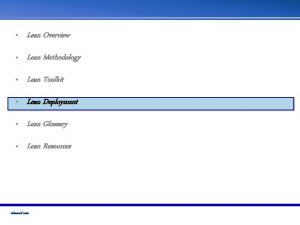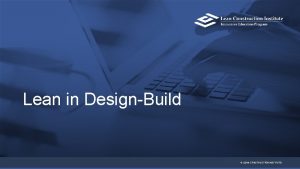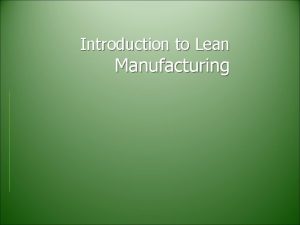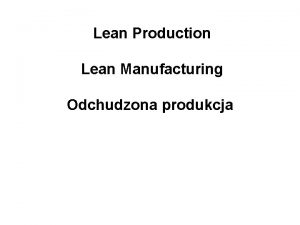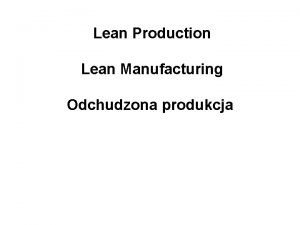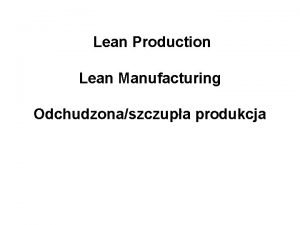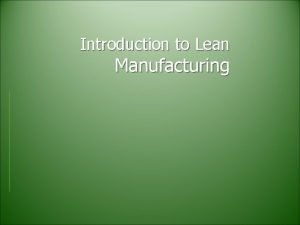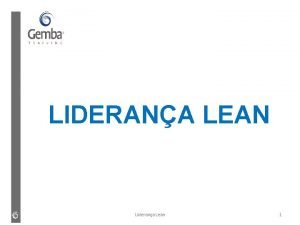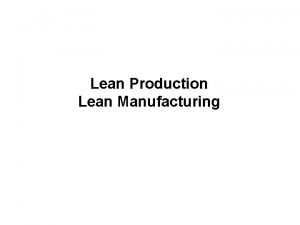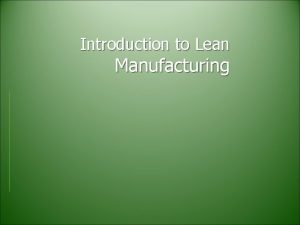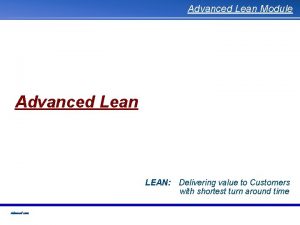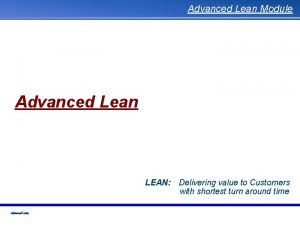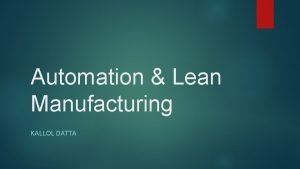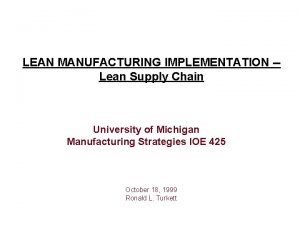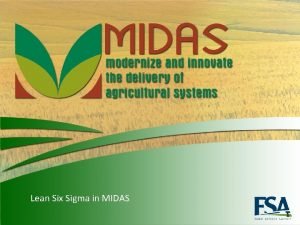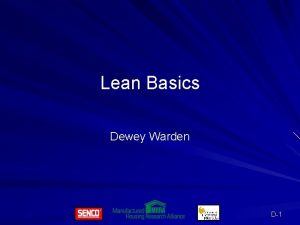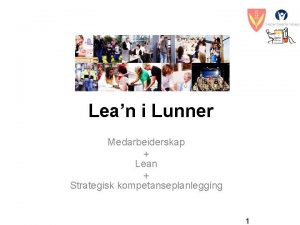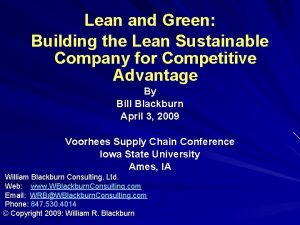Lean Accounting or Accounting for Lean Do You

























- Slides: 25

Lean Accounting or Accounting for Lean Do You Know the Difference? Presented by Mark C. De. Luzio, CMA – President & CEO Lean Horizons Consulting, LLC Presented to: Institute of Management Accountants, NERC 8 th Annual Conference September 22, 2015

Contents Introduction Lean Accounting – Case Study Accounting for Lean – Case Study Summary – Q&A 2 © Lean Horizons Consulting, LLC 2012. All Rights Reserved.

Definitions Lean Accounting Applying lean concepts to drive waste out of the accounting function itself Accounting for Lean Modifying the accounting process to properly deliver information which promotes lean behaviors Both are necessary in a Lean environment and must work hand-in-hand. 3 © Lean Horizons Consulting, LLC 2012. All Rights Reserved.

Why Lean Accounting? Lean Accounting Benefits ¢ ¢ ¢ Eliminates waste from the accounting process providing: § More timely information § Improved quality of information § Frees up accounting resources Allows the accountant to focus on the business: § Becomes a navigator rather than a historian § Allows the accountant to become a partner with management Customer focused: § Provides the customer what he wants, when he wants it § Eliminates unnecessary reporting 4 © Lean Horizons Consulting, LLC 2012. All Rights Reserved.

Why Accounting for Lean? Accounting for Lean Benefits ¢ ¢ ¢ Discourages dysfunctional behaviors: § Building unnecessary inventory § Long production runs that do not meet customer demand § Un-Lean decisions based on variance optimization § Capital decisions based on traditional decision making More accurate financial information: § Focus on Value Stream provides comprehensive cost picture § More accurate product costs since allocations are reduced/limited Greater accountability: § Cost data is not arbitrary § Financials give management vehicle to control one’s destiny 5 © Lean Horizons Consulting, LLC 2012. All Rights Reserved.

Contents Introduction Lean Accounting – Case Study Accounting for Lean – Case Study Summary – Q&A 6 © Lean Horizons Consulting, LLC 2012. All Rights Reserved.

Situation Analysis – Jake Brake 1988 Accounting Department Headcount n Sales: $65 million Department n Market Share: 100% and declining Headcount 1988 Accounts Payable 3 Accounts Receivable 1 General Accounting 2 Payroll 3 n NPD Lead Time: 72 Months Cost Accounting 4 n Total Headcount: 550 Information Systems 12 n Accounting Headcount: 25 (See chart) Total 25 n Profitability: 3% ROS n Inventory Turns: 2 X n On-time Delivery: 45% n Lead Times: 8 -12 weeks Business was in dire straits, losing market share and profitability 7 © Lean Horizons Consulting, LLC 2012. All Rights Reserved.

Accounts Payable Kaizen Mail is Delivered Mail is Sorted Mail Opened File Vouchers Correct Exceptions Enter Invoices in System Batch Control Totals Major Area of Opportunity 8 © Lean Horizons Consulting, LLC 2012. All Rights Reserved.

Accounts Payable Quality Defects n Quality defects were the major contributor to n n n 9 productivity 75% of staff time spent on resolving quality defects Specific kaizen improvement events conducted for each type of quality defects Visual control of quality defects critical to making problems obvious to all Improvements involved many functions (Accounting, Purchasing, Receiving, Engineering, etc. ) Eliminating quality defects resulted in improved quality of payment to vendors, higher productivity and reduction of troubleshooting calls from vendors © Lean Horizons Consulting, LLC 2012. All Rights Reserved.

Kaizen Approach Actions Taken n Standard Work developed for Accounts Payable process n Accounts Payable Cell designed and implemented n One Piece Flow established n “Hospital Bed” implemented for quality defects n Implemented root-cause quality tracking and improvement system 10 © Lean Horizons Consulting, LLC 2012. All Rights Reserved.

Standard Work – Accounts Payable 11 © Lean Horizons Consulting, LLC 2012. All Rights Reserved.

Kaizen Results Item Before After % Improvement Headcount 3 1 -66% Productivity (Vouchers/Hour) 8. 3 25 +200% 1 st Pass Defects (PPM) 650, 000 PPM -92% Duplicate Payments - ELIMINATED - Duplicate Filing/Docs - ELIMINATED - 12 © Lean Horizons Consulting, LLC 2012. All Rights Reserved.

Overall Improvements Department Headcount 1988 Headcount 1989 Difference Accounts Payable 3 1 -2 Accounts Receivable 1 0 -1 General Accounting 2 2 0 Payroll 3 2 -1 Plant Controllers 0 3 +3 Cost Accounting 4 0 -4 Information Systems 12 2 -10 Total 25 10 -15 13 © Lean Horizons Consulting, LLC 2012. All Rights Reserved.

Contents Introduction Lean Accounting – Case Study Accounting for Lean – Case Study Summary – Q&A 14 © Lean Horizons Consulting, LLC 2012. All Rights Reserved.

Situation Analysis – Jake Brake 1988 n n n n n Traditional “batch and queue” standard cost accounting system MRP-driven work order costing approach Absorption costing – promoted excess inventory build Overhead applied on the basis of direct labor hours Cost accounting variance analysis promoted non-Lean behaviors Inventory records inaccurate and meaningless Exhaustive labor reporting system – cumbersome, tedious and provided little value to management High volume of inventory and labor transactions Inaccurate product costing 15 © Lean Horizons Consulting, LLC 2012. All Rights Reserved.

Actions Taken 1. Developed Value Stream Costing Methodology n Eliminated work orders and MRP shopn n n n level scheduling Treated all labor as a direct overhead cost Value streams became profit centers with stand-alone P&L Eliminated arbitrary overhead allocations: (Direct costs increased from 35% to 80%) Value stream inventory was backflushed “wall to wall” Ability to track cell cost performance in addition to the entire value stream Accuracy of product costs greatly enhanced Eliminate variance reporting (more later) Value Stream Managers had greater control of their destiny! 16 © Lean Horizons Consulting, LLC 2012. All Rights Reserved.

Actions Taken - continued 2. Eliminated Overhead Variance Analysis and Absorption Accounting Variance Absorption Variance Machine Utilization Non-Lean Outcomes/Behaviors • Building of unnecessary inventory • Reluctance to change over equipment • Reluctance to perform necessary PM procedures • Promotes buying excess inventory due to quantity Purchase Price Variance Direct/Indirect Labor Ratio Direct Labor Variance Analysis Overhead Variance Analysis discounts • May compromise quality and delivery over price considerations • Used direct operators for indirect purposes • Minimized the importance of indirect labor activities • Use of lowest cost resource regardless of skill set • Piece rate encouraged the building of unnecessary inventory, and compromised quality • Favorable variances interpreted as good, regardless of continuous improvement trend 17 © Lean Horizons Consulting, LLC 2012. All Rights Reserved.

Actions Taken - continued 3. Redesigned Capital Appropriation Request (CAR) Procedures Old CAR Requirements ROI/NPV • TAKT Time Analysis • • • Revised CAR Requirements Equipment flexibility Kaizen opportunities of old equip Quality ratings (Cpk) of new equipment Changeover capabilities of new equip. Flexibility vs. Monument Technical support required Is the new equipment consistent with the Lean philosophy? 18 © Lean Horizons Consulting, LLC 2012. All Rights Reserved.

Actions Taken - continued 4. Established Target Costing Target costs established based on market pricing n Accountants proactively worked with multi-functional design team to reduce costs and hit desired profitability during the design phase: n Material considerations Manufacturing considerations Etc. Created pro-forma standard work and cell design methodology to simulate new product manufacturing process n Multi-functional involvement: Purchasing, Design Engineering, Manufacturing Engineering, Marketing, Accounting n Old Formula: Cost + Profit = Selling Price New Formula: Selling Price – Cost = Profit 70% of a product’s cost is locked in during the design process 19 © Lean Horizons Consulting, LLC 2012. All Rights Reserved.

Actions Taken - continued 5. Eliminated Unnecessary Reporting n n n 70% of management reports were deemed non-value added and eliminated Based on Voice of the Customer New computer system provided real time access to necessary information Provided what was necessary, when necessary Reliance on visual management to provide real-time feedback Most of the information that we were providing was not needed, and we found that we were not providing the required information most of the time 20 © Lean Horizons Consulting, LLC 2012. All Rights Reserved.

Actions Taken - continued 6. Implemented Hoshin Planning (Strategy Deployment) Strategic Deployment SD Planning n n n Focuses on the implementation of breakthrough objectives Links breakthrough objectives with specific resources Aligns resources within the company SD Implementation n Facilitates on-going review of progress (PDCA) Results in specific action plans and measurements Is always a dynamic process Strategic Deployment fosters management to work ON the business not IN the business 21 © Lean Horizons Consulting, LLC 2012. All Rights Reserved.

Actions Taken - continued 7. Reassigned Roles of Accountants n n n Moved accounting staff to the shop floor Cost Accountants were promoted to Plant Controllers Assigned to cross functional business teams and Value Streams Gained experience – “business within a business” Became navigators rather than historians Responsibilities included: Target Costing Value Stream Costing and Reporting Capital Expenditure Analysis and Reporting Product Costing Cost Improvement Initiatives 22 © Lean Horizons Consulting, LLC 2012. All Rights Reserved.

Contents Introduction Lean Accounting – Case Study Accounting for Lean – Case Study Summary – Q&A 23 © Lean Horizons Consulting, LLC 2012. All Rights Reserved.

Jake Brake Results 1988 1999 $ 65 Million $ 200 Million Sales Revenue 550 575 Headcount 240, 000 Floor Space (Sq Ft) 240, 000 2 X 25 X Inventory Turns <20% 99% On-Time Delivery 3. 0 35. 0 Productivity 85 Days 2 Days Lead-Time 75, 000 PPM <5, 000 PPM Quality 4% >30% Operating Income Development Cycle 72 Months 16 Months 24 © Lean Horizons Consulting, LLC 2012. All Rights Reserved.

Contact Information n Mark De. Luzio, President & CEO +1 860 -430 -1174 mark. deluzio@leanhorizons. com www. leanhorizons. com 25 © Lean Horizons Consulting, LLC 2012. All Rights Reserved.
 Lean accounting definition
Lean accounting definition Lean accounting ppt
Lean accounting ppt Kontinuitetshantering i praktiken
Kontinuitetshantering i praktiken Typiska drag för en novell
Typiska drag för en novell Tack för att ni lyssnade bild
Tack för att ni lyssnade bild Vad står k.r.å.k.a.n för
Vad står k.r.å.k.a.n för Varför kallas perioden 1918-1939 för mellankrigstiden
Varför kallas perioden 1918-1939 för mellankrigstiden En lathund för arbete med kontinuitetshantering
En lathund för arbete med kontinuitetshantering Kassaregister ideell förening
Kassaregister ideell förening Personlig tidbok
Personlig tidbok A gastrica
A gastrica Förklara densitet för barn
Förklara densitet för barn Datorkunskap för nybörjare
Datorkunskap för nybörjare Boverket ka
Boverket ka Debattartikel mall
Debattartikel mall Magnetsjukhus
Magnetsjukhus Nyckelkompetenser för livslångt lärande
Nyckelkompetenser för livslångt lärande Påbyggnader för flakfordon
Påbyggnader för flakfordon Lufttryck formel
Lufttryck formel Publik sektor
Publik sektor Kyssande vind
Kyssande vind Presentera för publik crossboss
Presentera för publik crossboss Teckenspråk minoritetsspråk argument
Teckenspråk minoritetsspråk argument Plats för toran ark
Plats för toran ark Treserva lathund
Treserva lathund Mjälthilus
Mjälthilus


























